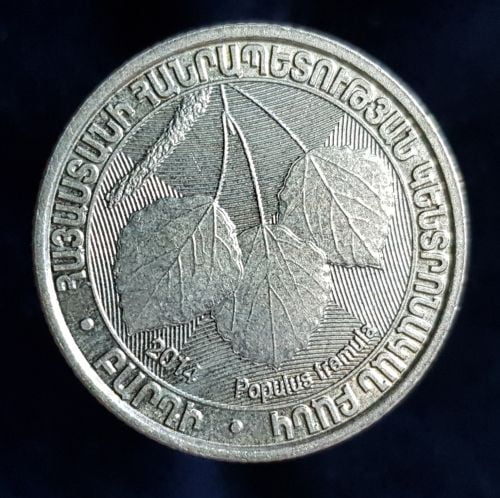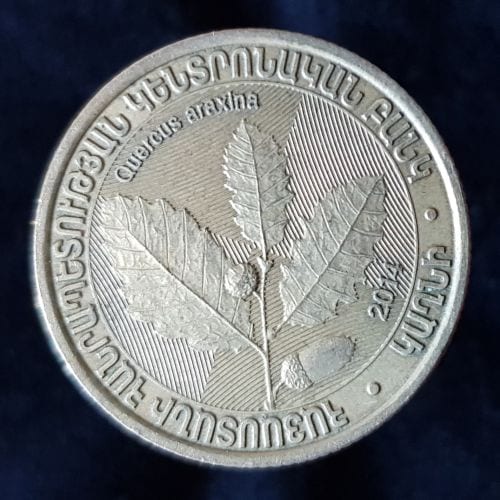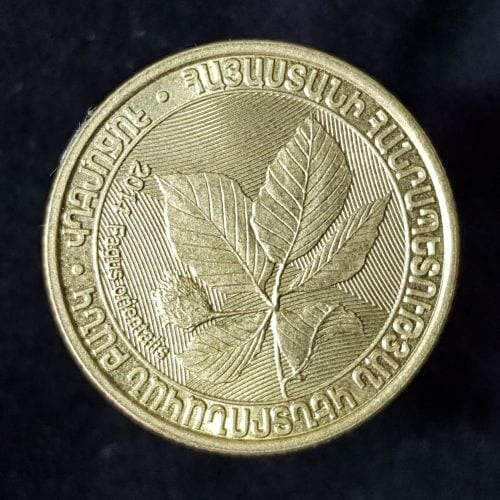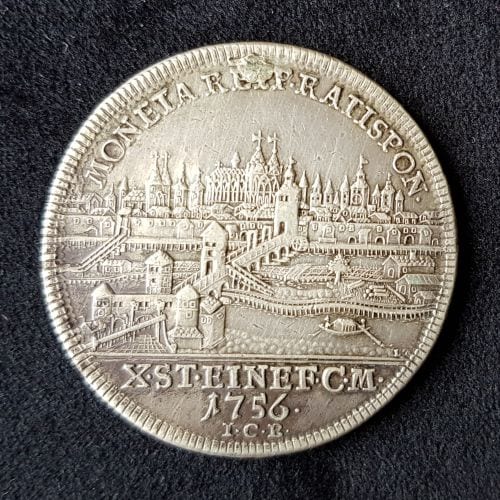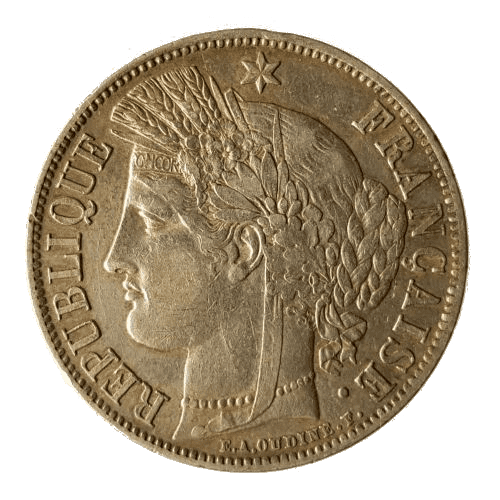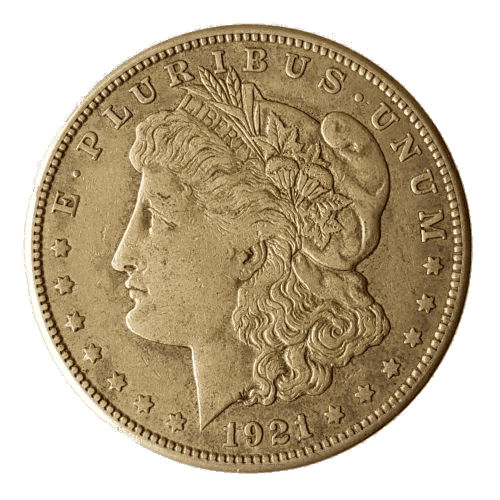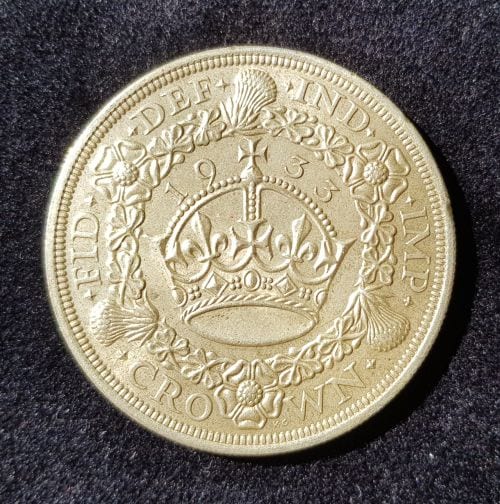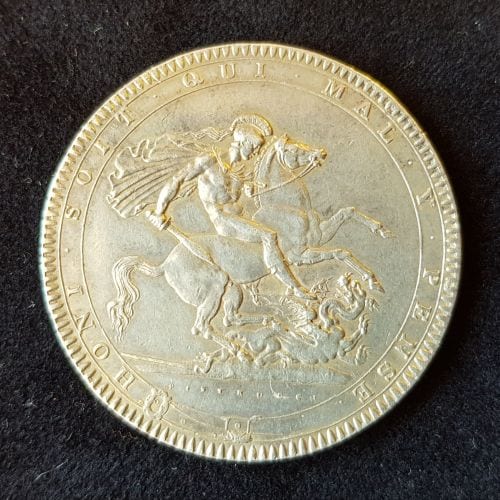
Coin iconography
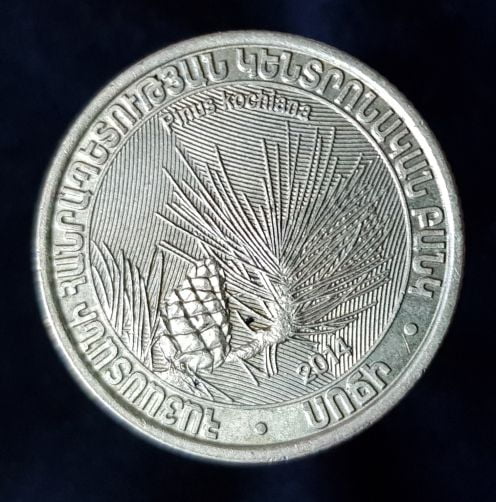
Pine tree – Pinus kochiana
Armenia 200 dram – 2014 – high-standard botanical illustration incorporated into coin design
4.5 g Brass-clad steel, 24 mm; edge 1.45 mm reeded . KM#286 – Uncirculated
Image Roger Spencer
Coins are visual images, symbols, or representations of objects or ideas. The word ‘icon’ once referred to the venerated and sanctified images of religion, but it has gradually become more mainstream, now applied to emblems, logos and, in recent times, the simple stylized messaging pictures we use on our smartphones.
Iconography is powerful because it conveys a message quickly and efficiently, like the smiley face at the end of an email.
Among the many sources of plant iconography are the cave paintings of prehistory, ancient art where plants are included in architecture, sculpture, frescos, mosaics, bas-reliefs, carvings, and tapestries. There were the illustrations that appeared in fragile scrolls, manuscripts, incunabulae and codices, then the printed herbals with their woodcut pictures followed by many forms of graphic art, painting, botanical art, photography, and a recent avalanche of technology that produces plant images of every conceivable kind today.
One neglected form of botanical art is the skilled engraving (celature) of plant images (plant iconography) that appears on coins of the world. The fascination of coins is that they are attractive, mass-produced, communal, and universally accessible physical objects that persist, with little alteration, through long periods of time. Like other historical artefacts and antiques they fascinate because they combine human technological, scientific and artistic ingenuity into a tangible connection with the past. Like a flag, logo, or emblem they provide a focus of identity for social groups – usually nations.
Most coins have been widely handled and shared by people from all walks of life, keeping secret the drama of their individual circumstances. Unlike other art ‘objects’ such as symphonies, works of philosophy, and fine art, they can be appreciated without extended interpretation or special education. They are a physical object that is an unchanging record of time and place and, as part of a collection, they will persist long after we die. They are, inevitably, richly entwined with history and, if so desired, a source of study and amusement.
Handling coins from the past we touch objects of often elemental purity, distilled by human industry, science and technology, enhanced by creative design and rich in historical social and political meaning and symbolism. They are, at the same time, everyday objects that have passed through the hands of all sectors of society in the simple human act of exchanging goods and value – presenting themselves to us in physical reality exactly as they appeared to our forebears.
Coins are, however, more than just a window into economics, history, and art – they are manifestation of the social organization of civilizations – their science and technology, transport and trade, and much much more. The familiar round and ornamented coins we know today arose in ancient Greece in a tradition that passed quickly to Persia and then (via the Seleucids, Parthians and Sassanians) to the Islamic world. Some of the finest Western art appeared on the gold, silver and bronze or copper coins of Ancient Greece and this tradition also probably passed to India via the Achaemenid empire and here, in India, some of the most beautifully adorned coins of the classical era were produced at the mint of Samudragupta (335-376 CE). The coins of ancient China have their own unique history.
The imagery on the coins of the world today traces the waxing and waning of civilizations – their leaders, emblems and icons. It had taken the practical form of a round, flat disk of precious metal. The iconography advertised two faces of political and economic power – of religious and earthly rulers (heads) coupled with heraldic symbols and local emblems (tails) in a tradition that has continued to today – but with a peak of creativity stimulated by the nationalism of European empires in the 16th to 19th centuries.
The natural world was not ignored, but it was the symbolism of powerful animals, real or fictitious, that prevailed – the dragon, griffin, pegasus the flying horse, snake, wolf, lion, elephant, bull, ram, turtle/tortoise, wild boar, and horse. From the birds, the eagle and owl, and from the sea the dolphin, tuna, crab, and octopus. The eagle symbolized Zeus (Jupiter), the king of the Gods, a popular image on coins up to the present day.
Unsurprisingly plants have played a lesser role. The rose is hardly a symbol of power (except perhaps for Britain’s War of the Roses!). It is plant utility that usually features on early coins, the wheat, barley and rice, their passive beauty probably displayed for the first time on a coin as the rose emblem of ancient Rhodes. Few plants appear on the coins of the Roman world, and only recently have they, once again, begun to reappear.
This article explores the world’s graphic design and plant art as it appears in a gallery of global coinage that explores changes in artistic ideas and metal technology. A similar and perhaps more revealing gallery could be developed for plant iconography on stamps and banknotes while perhaps the world’s most comprehensive compilation can be found on the website Numista when using the search category ‘flower’. The Australian National Botanic Gardens has assembled a list of Australian plants on Australian postage stamps.
But to really appreciate this art form when applied to coins, it is first necessary to appreciate the broad history and principles of money. To do this we must enter the world of numismatics and the numismatist who studies currency, mostly coins and banknotes and occasionally coin tokens and medals (exonumia).
Money
Money may be defined as a medium of exchange for goods of different value: it is therefore both a measure of value, and a store of value for the future. In common parlance it refers to the coins and banknotes used as a means of payment.
Value
Coins are a communally-accepted source of value within the region of an issuing authority. Their advantage is that their value is independent of any particular commodity so they are a general-purpose medium of exchange. For this reason, in civilizations that had mastered metallurgy, they replaced the former system of barter and metal exchange.
Throughout history countries have had difficulty in making the value of the metallic content of coins equal the value given on the face of the coin. As soon as the coin value becomes less then its face value becomes a matter of trust – becoming, in effect, fiat money. By the 1960s the silver content of circulated silver coins had dropped below face value, the cost of the elemental metal. In America the Coinage Act of 1965 eliminated silver from the circulated dimes and quarter dollars of the United States, most other countries doing the same with their coins which thus became fiat money. Fiat money became dominant in the 20th century when the US dollar was decoupled from gold in 1971, the same year that decimalization occurred in the UK as national fiat currencies became global.
Adoption of ‘Gold Standard’ (Paper currency convertible into gold)
COUNTRY – YEAR
United Kingdom 1821
Germany 1871
Sweden 1873
United States (de facto) 1873
France 1874
Belgium 1874
Italy 1874
Switzerland 1874
Netherlands 1875
Austria-Hungary 1892
Japan 1897
Russia 1898
United States (de jure) 1900
Monies
Early stores of exchange value – different kinds of money – included stone tools, cowries and other shells, household objects, figurines, barley, wool, wine etc. Later this took the form of the generally accepted inherent value present in hoarded metal ingots made of mostly gold, silver and copper. Hoards around 1000 BCE were mostly of pieces of silver, a few with simple inscriptions. However, for daily exchange there needed to be an object that was both long-lasting while being easily carried and stored. Influential aristocratic families and merchants began issuing metal ingots of standard weight and size as tokens on which were punched simple identifying symbols.
From these mostly locally-used metal tokens developed the coinage we know today, becoming widespread when sanctioned by governments as an agreed source of precisely defined value.
Commodity money is made from a good, like a precious metal which has value beyond its use as a medium of exchange (it is a commodity).
Representative money, though similar to fiat money, represents a redeemable claim on a commodity.
Fiat money is has little or no intrinsic value but is usually established by government regulation or because traders have agreed on its value. Fiat money was introduced as an alternative to commodity money and representative money.
Bullion
Bullion is gold, silver, or other precious metals in the form of bars or ingots although it includes coins of high precious metal content which maintain their value better than conventional currencies and which are therefore stored as a form of emergency currency by both governments and private citizens. ‘Bullion’ is derived from the French ‘bouillon’- boiling, a term used for the melting house where ingots or bars are poured from the raw material.
Currency debasement
Though the initial intention of metal coinage was to provide an absolute source of value, even in Greece it became conventional for states to make the face value of coins greater than their actual value, the ensuing profits for the state now being known as seignorage.
The Spanish silver dollar was the base currency of the Spanish Empire following its monetary reform in 1497. Worth 8 Spanish reales (Spanish Real de a ocho or peso, a silver coin 38 mm wide) these coins were widely known as ‘pieces of eight’ in an era when pirates and treasure were associated with the Caribbean in particular. For many years Spain was the leading western European political and economic power with trading hubs accessing silver from mines in South America at the start of the modern era. Following reform the Spanish dollar was of standard size and metal content which appealed to the western European empire building countries and, by the 18th century, had become the first international currency of the modern era, widely circulated in Europe, the Americas, and the Far East. The origin of the ‘$’ symbol is generally related to the columns and stripes that appear on the reverse face.
Some countries, like Australia, counter-stamped or punched these dollars in some way to act as local currency. This was the forerunner of many dollar-like coins including the US dollar which remained legal tender in the United States until the Coinage Act of 1857, Canadian dollar, the Japanese yen, the Chinese yuan, the Philippine peso, and various other coins of the Americas.
‘Peso’ was the Spanish term for this denomination which became the basis for many of the currencies in the former Spanish colonies, including Argentina, Bolivia, Chile, Colombia, Costa Rica, Cuba, Dominican Republic, Ecuador, Guatemala, Honduras, Mexico, Nicaragua, Paraguay, Philippines, Puerto Rico, Peru, Salvador, Uruguay, and Venezuelan pesos.
Millions of Spanish dollars were minted over the course of several centuries. They were among the most widely circulating coins of the colonial period in the Americas, and were still in use in North America and in South-East Asia in the 19th century.
The Joachimsthaler weighed 451 Troy grains (29.2 g)[2] of silver (a grain was a measure of mass in the troy weight, avoirdupois, and Apothecaries’ system – exactly 64.79891mg – based on a theoretical cereal grain). ‘Thalers’ were then minted in Burgundy and France, Burgundy at that time fighting the Spanish king. After 1575, the Dutch provinces replaced the currency with the leeuwendaalder (‘lion dollar’ after its reverse design) which contained 427.16 grains of 0.750 fine silver, lighter than the large denomination coins then in circulation. In the 17th century (the Dutch golden age) leeuwendaalders rather than other heavier, more costly coins became the coin of choice for foreign trade in the Middle East, and colonies both east and west including the English colonies during the 17th and early 18th centuries. In America the lion dollar spread to all thirteen colonies where, by 1581, the word ‘dollar’ was also being used for the Spanish peso or ‘piece of eight’ which was also in wide circulation especially around the time of the American Revolution and thus adopted as the name, weight, and metallic composition of the basic monetary unit of US currency.
Banknotes
The first banknotes were issued in China in the 7th century but in the 11th century government created a monopoly on their issue of jiaozi as it was known during the Song Dynasty in China. Marco Polo recorded the use of this fiat money in the 12th century account of his travels in Asia. Today paper/plastic money is used across the world, usually in combination with commodity currencies.
New money
From the late 19th century to the 1930s charge coins (of various shapes and sizes and materials including celluloid (an early plastic), copper, aluminum, steel etc., often with a hole for a key ring.) They were used by customers with charge accounts in department stores, hotels etc. and carried a charge account number with the merchant’s name and logo and was a simple way of charging an account.
The Charge-Plate, developed in 1928 and used in the USA into the late 1950s was a precursor to the credit card made of sheet metal like a military ‘dog tag’ embossed with the customer’s name, city, tate and paper signature on the back. The plate was laid on an imprinter with a ‘charge slip’ on top and transaction recorded as an embossed impression.
In 1934, American Airlines introduced the numbered Air Travel Card that identified both issuer and customer account introducing a system of credit as ‘buy now, pay later’ and a discount for card users.
This was followed by general-purpose charge cards, customers paying different merchants with the the same card (e.g. Diners Club of the 1950s) with bills paid upon the issue of a statement. In 1958 American Express created a worldwide credit card network (charge cards with credit card features) and this became nore efficient with the 1958 BankAmericard.
The efficiency of the credit card system was vastly increased when computerized in 1973 although delays occurred until always-connected payment terminals became ubiquitous at the beginning of the 21st century.
This brief outline of the history of money traces its origins in actual commodities to the use of metal ingots of negotiated value to metal tokens with simple designs, to coinage sanctioned by governments with elaborate designs on the two surfaces. Coinage was subsequently supplemented by banknotes, plastic credit cards and, in more recent times, the use of virtual of electronically recorded transactions such as bitcoin.
Mints
In Ancient Greece the numerous mints struck coins for their individual nation-state while Roman mints were mostly imperial institutions. Numismatists have constructed maps of the Greek, Roman, Byzantine, Asia Minor and Medieval mint city regions and territories.
In Europe of the Middle Ages three mints were established around the time of Charlemagne: Hamburg in 834), Paris’s Monnai de Paris in 864, and England’s Royal Mint in 886.
Mints, as centres of coin production, spread out from Lydia (in today’s Turkey) of around 600 BCE by the Lydian people of modern-day Turkey so that within 100 years mints with their own coinage existed in Athens, Aegina, Corinth and Persia. had all developed their own coins.
Following the emergence of milled (machine-made coins) in the 16th century it became customary for national currencies to be minted by either a country’s central bank or via the central bank as a commission to an independent mint. So, for example the coins of New Zealand are minted jointly by the Royal Mint in the United Kingdom, and the Royal Canadian Mint, for the Reserve Bank of New Zealand. In recent times many national mints have been privatised to become state-owned enterprises allowing them to pursue their own commercial interests. So, for example. In June 2007 the British Royal Mint became a corporation – granted some commercial freedom by becoming a government-owned company. Privatisation has resulted in a flood of commemorative coins, medals and different types of bullion, often ornamental to reflect topical or popular themes and entertainment.
The world’s oldest constantly running mint is the Monnaie de Paris in France, founded in 864 CE, the second is the British Royal Mint, founded in 886 CE.
A list of world mints is available on Wikipedia.
Today, National coinage is minted by either a country’s central bank or, on its behalf, by an independent mint. Many national mints in recent times have been privatised as state-owned enterprises generating revenue by producing commemorative coins, medals, and bullion.
Coin design today
A coin designer prepares detailed sketches. Once approved, the coin is modelled using either computer design software or modelling clay and plaster. For the latter a large model of the coin is sculpted on a sheet of glass, a steel ring is then placed around the model and filled with plaster to form a reversed ‘negative’ cast of the design. The first model is then used to make a second ‘positive’ plaster cast used to refine the design which is then transferred to a computer using a 3D digital scanner and computer-aided design used to add words and dates.
Coin technology
Coins have been produced by three major means: hammered, milled, or cast. The first mills or presses in the West marked the beginning of machine-struck coins that began in the early 18th century, first as ‘screw presses’ then in the 19th century as ‘steam-driven presses’ built first in France and Germany but followed rapidly by Britain and evolving in recent times into electric and hydraulic presses.
Coin metals
Among the first minted coins of Lydia were those made from a naturally-occurring alloy of gold and silver called electrum, a Latinized word from the Greek ἤλεκτρον-èlektron that is mentioned in Homer’s Odyssey and, from this region, now known to contain 45–55% gold.[wp]
Coin metal needed to be workable, durable, and resistant to wear. The numismatic abbreviations indicating the composition of ancient coins was:
AV – gold
EL – electrum
AR – silver
BI – billon
AE – bronze
PB – lead
Gold and silver were always revered as precious metals with gold having a symbolic significance related to the Sun. Even in ancient times coin debasement was practiced, billon being an alloy of copper and silver but with more than 50% copper. Bronze was alloyed in many different ways.
During the 18th and 19th centuries coins were composed almost exclusively of the metals bronze (Cu-Sn), copper (Cu), silver (Ag), gold (Au). To this list was later added Platinum (Pt), Copper (Cupro-)-Nickel (Cu-Ni), Nickel (Ni), Tin (Sn), Zinc (Zn), Aluminium (Al), and Lead (Pb).
Platinum coins were first minted in Spanish-colonized America in the 18th century and then by the Russian Empire in the 19th century but unlike the more malleable and ductile silver and gold, it is not easily worked. However, because of its novelty commemorative coin sets have been struck from 1978 as bullion coins: like the American Platinum Eagle, the Canadian Platinum Maple Leaf, the Australian Platinum Koala, the Isle of Man Noble, the Chinese Platinum Panda and several series by the Soviet Union and then the Russian Federation.
The first coins made out of the rare silver-white transition metal palladium were produced in 1966 by Sierra Leone, followed by Tonga in 1967 and later by Canada, the Soviet Union, France, Palau, Portugal, Russia, China, Australia and Slovakia, mostly as commemorative coins with the Russian Federation minting the largest.
Coins of antimony were issued in China’s Guizhou province in 1931 but the durability was poor and the minting was soon discontinued. A comprehensive account of metals used in coins and medals by Tony Clayton is available at http://www.coins-of-the-uk.co.uk/pics/metal.html. He acknowledges the book ‘The Teach Yourself Guide to Numismatics’ by C.C. Chamberlain (1960) as a major source of his information.
History of coinage
We may never unravel the precise origins of coinage. There are conflicting claims made not only by ancient historians like Herodotus (c. 484 – c. 425) and the later Greek scholar Julius Pollux (fl. 2nd century) but also by modern archaeologists and numismatists.
Coinage is derived from three geographically independent regions – the West (including Persia), India, and China.[1]
Unfortunately, dates did not appear on early Greek coins although occasionally the mint was indicated, or the local magistrate and, less frequently, the name or initials of the celator (the designer-engraver).
The History of Coins & Currency (part 1) – 600 BCE – 1500 CE
Courtesy – Youtube – Ollie Bye
First coins
Aristotle claimed that the origin of Greek coinage was facilitated by Hermodike II (Hermodice, Damodice or Demodike), wife of the third dynastic King Midas[8] of Phrygia.[7] Hermodike was the daughter of king Agamemnon of Cyme (modern Turkish Nemrut Limani) the most important city of Aeolis (western Asia Minor with Ionia to its north and Lydia to its east), and it appears she was able to transfer technical information from Lydia (to the Greeks a foreign land with a foreign language) into Greece via Aeolis. Herodotus refers to a king Midas (not necessarily the same king Midas) ruling his people from a castle surrounded by a beautiful garden where ‘roses grow of themselves, each bearing sixty blossoms and of surpassing fragrance.’
Further complications were added when, in 1904, excavations of the Temple of Artemis in Ephesus unearthed a hoard of 90 uniform-weighted but variously stamped electrum coins associated with Lydian King Alyattes (610–560 BCE), father of wealthy King Croesus (595– c. 546 BCE) was the king of Lydia who reigned for 14 years from 560 until his defeat by Persian king Cyrus the Great in 546. The dating of this hoard has not been fully resolved but Alyattes is often said to have introduced the first coin, the Lydian Lion coin made from naturally occurring electrum while Croesus introduced a bimetallic system of unalloyed gold and silver coins with bronze coins following later, in the 5th century BCE.
Other accounts source the first coins to the rulers of the island of Aegina a rival to Athens located about 20 km at sea from Athens in the Saronic Gulf. So, for example:
‘Pheidon of Argos established a mint in Aegina, the first city-state to issue coins in Europe, the first coin being the Aeginetic stater’.[9] One stamped Aegean electrum stater is held in the Bibliothèque Nationale of Paris, stamped with a turtle, sacred to Aphrodite, and dating from 700 BCE. This pre-dates by 30-40 years the use of coins in Asia Minor by the Ionians and Lydians (c. 630 BC), so Aegeans may have introduced coinage to the Western world. The Aeginetic standard of weights and measures (developed during the mid-7th century) was one of the two standards in general use in the Greek world (the other being the Euboic-Attic) suggests the early commercial importance of the island. The Aeginetic weight standard of 12.3 gm was widely adopted in the Greek world during the 7th century BCE. The Aeginetic stater was divided into three silver drachmae each of 4.1 gm. Staters portraying sea-turtles were struck up to the end of the 5th century BCE to be followed after the Peloponnesian War in 404 BCE by the land tortoise.[wp]
Part of the difficulty is that some time probably passed from when coins were first used as tokens among merchants before they passed into public commerce. Stamping the coin with some symbol associated with its ‘denomination’ avoided the elaborate process of weighing.
Standardization
Ingots, pellets, & tokens
Coinage evolved as a standardization in the weight and purity of metal ingots used for exchange during the late Bronze Age – like the weighed bullion of Mesopotamia, the silver bars that were used as currency in Central Asia from the 6th century BCE, and the iron bars that were used parts of the Mediterranean.
Dates for the first coinage are also confused by a ‘heraldic’ period of metal tokens that were issued by individual merchants, carrying their special symbol, before minted coins became the preserve of the state.
Coins
The earliest coins similar to those of today originated as metal pellets (blanks or planchets) of standard weight struck between a permanent die – which was an engraved image fixed on an anvil (the obverse) – and an arbitrary die symbol on the hammer-like punch (reverse) wielded by the coin maker. This way of striking or minting coins, known as ‘hammering’, was a technology that would persist until the 17th century.
At first simple punch marks were used but soon designs took the form of a badge, logo or emblem that could represent a special deity, person, place, or object. Most frequently they displayed the iconography of religious, political or economic power.
We might assume that world coinage has taken the form it has through a long process of trial and error, in response to developments in technology and changing social circumstances and needs. Perhaps surprisingly many of the characteristics we know today were established very early in history.
The first coin-like metal tokens arose around 650 BCE. By around 550 BCE most of the general characteristics we associate with today’s coinage – its shape, composition, weight, and iconography – had already been adopted:
– round
– bifacial, flattened, though often high relief faces differentiated into a front and back, reverse and obverse, ‘heads’ and ‘tails’
– at first the heads or obverse face portrayed a sacred theme, usually the image of a deity, while the reverse carried an image of some regional identification such as a widely traded object or a representation of an object from regional mythology
– a rough indication of value was related to the value placed on metals – the most precious being gold, followed by silver and then bronze (an alloy of copper and tin)
– coin denominations (categories of value) were further refined by using standardised weights for each denomination. Athenian coinage was in competition with that of Aegina, using its own Attic standard of weight of 17.2 grams at (4.3 grams per drachma) while New Style coins fall within the 16.25-16.95 g. range. Forgeries were occasionally made and test cuts may often be seen in the edges – not necessary removing a metal sample but checking for an inferior metal at the core.
– the anthropomorphic personification of cities and regions as goddesses
Denomination
The agreed value of coins is known as its denomination (like a penny or dollar, drachm or obol). Though many coins shared the same name, there were different standards of weight. So the drachm of Phoenician standard weighed 56 grains while, in the Aegenetic standard it weighed 97 grains. The ancient Persian standard was the siglos, that of Corinth the stater, and of Magna Graeca the nomos.
Metals
The metals used remained consistent for many years, either the precious metals gold and silver or the base metal alloy bronze (copper and tin) which wore better than the occasionally used copper. These standardizations have, however, varied confusingly by time and place and the desire to maintain the relative values of metals.
In ancient Greece gold was mostly worth 10 times the equivalent weight of silver.
In Europe of the 16th to 18th centuries the ratio of value gold to silver was maintained at around 15:1. However, with the removal of silver from coins (debasement), and the introduction of a gold standard, the ratio for many nations increased to around 100:1.
Hand-punched coins of the Classical era, most notably those of Greece, reached a level of artistic sophistication that would not be attained again until the milled (machine-made) coins of the 18th century.
Just as ancient Greece became a cosmopolitan country through its ‘turtles’, ‘owls’ and ‘Alexanders’ and Rome through its ‘denarius’ so, as historical political and economic power moved between Western European nations, each became familiar to the other through its coinage: the Spanish reale, Dutch ducats and guelder, Mexican peso, French franc, English crowns or pounds, and American dollars.
Lydia
King Croesus is credited with the introduction of a bimetallic (separate gold and silver coins) system of coinage stamped with the opposing power symbols of the lion and bull. This coinage minted in his kingdom of Lydia in today’s southwest Turkey may have been the first coinage in history to take the familiar form we know today.
The first recorded coins are associated with Iron Age Anatolia and its kingdom of Lydia in in the late 7th century BCE. Lydia produced the early electrum coins (typically 54% gold to 46% silver) that were not standardized in weight and probably at first used as ritual objects, like medals or tokens issued by priests. Electrum, once thought to occur naturally in the region is now considered a deliberate alloy with the advantage that it would overcome the problem of speculation on one particular metal. Lydian coins generally had no writing as a legend or inscription, only an image of a symbolic animal. Dating these early electrum coins is an imprecise art that depends on archaeological evidence such as that from excavations at the Temple of Artemis at Ephesus.
The lion was a royal animal, the powerful king of beasts; a magnificent, courageous and beautiful provider of riches, its flame-like yellow mane symbolizing the Sun and gold. The bull was also an animal of power that had formerly represented heaven in Babylonia and Syria and royalty in ancient Egypt, used as a sacrifice in religious rituals for millennia. The lion had been selected as the symbol of the Mermnad dynasty that preceded Croesus. Though the capital of Lydia was Sardis, the better-known coins were minted in coastal Ephesus.
Greece
The Greeks quickly learned from the Lydians, with three major centres of coin production during the Archaic period: Ionia, the Aegean, and Athens. Probably the first coins were minted on Aegina (a small island off the coast near Athens) shortly after the Lydian coins appeared. These first Greek Aegean coins were struck from silver and bore a turtle design, soon supplemented by ‘owls’ from Athens, the first coins to display designs on both surfaces rather than stamping an arbitrary incuse anti-counterfeit punch on the reverse, like the coins from Aegina. Owls depicted the goddess Athena on the obverse, and an owl on the reverse.
Persia
Following defeat by Persian king Cyrus the Great (550–530 BC) around 546 BCE the Lydian bimetallic system was adopted by the Achaemenid Persian empire which retained the former system until Darius I (521–486 BC) introduced a new thick gold coin (95.83% pure), the darius, with a standardized weight of 8.4 g and equaling in value 20 silver siglos coins. These gold coins carried an image of either the Persian king or a warrior with bow and arrow. Their use ended with Alexander the Great’s successful invasion in 330 BCE when most were melted to be recoined bearing Alexander’s image with the originals becoming extremely rare. Coins bearing an image of a king or ruler, often treated as a royal prerogative and strongly guarded.
Using coins for commerce took a while, the first probably small silver fractions, Hemiobol, Ancient Greek coinage minted by the Ionian Greeks in the late sixth century BCE. In contrast historian Herodotus (originator of the word ‘history’ from the Latin ‘historia’) mentions the innovation made by the Lydians:
‘So far as we have any knowledge, they [the Lydians] were the first people to introduce the use of gold and silver coins, and the first who sold goods by retail’ — Herodotus
Many of the early Lydian and Greek coins were minted privately like tokens with, at first, just a few as official state issues. The earliest inscribed coins are those of Phanes, dated to 625–600 BC from Ephesus in Ionia, with the legend ΦΑΝΕΟΣ ΕΜΙ ΣΗΜΑ (or similar) (‘I am the badge of Phanes’), or just bearing the name ΦΑΝΕΟΣ (‘of Phanes’). The first electrum coins issued by a monarch are those minted by king Alyattes of Lydia (died c. 560 BCE) who is sometimes described as the originator of coinage.
Islam
Following the death of Prophet Muhammad in 632 CE the caliphate expanded into the Byzantine and Sasanian (Neo-Persian) empires. Internal conflict resulted in the triumph of the Umayyad dynasty in 661 CE (41 AH)[10] as Islam absorbed much of the Middle East and North Africa.
At first the monetary systems of subjugated territories were left in place – essentially the gold-based Byzantine coinage and silver Sasanian coins. In AH75 (695 CE) the 6th Umayyad caliph Abd al-Malik ibn Marwan trialled new silver (dirham) and gold (dinar) coins, the dinar based on the Byzantine solidus which weighed 4.4 g and was 20 mm wide. In AH77 these experimental dinars were replaced by dinars of 4.25 g standard weight, equivalent to that of a worn solidus, and with a new design. Graven images were forbidden under Muslim law so both sides simply bore Arabic script of verses from the Qur’an. Aniconism, the tradition of ‘patterns not pictures’ is perhaps more familiar in Islamic architecture, the tradition continuing throughout the Umayyad period creating an Islamic coinage tradition that had been established between 75 and 77 AH.
China
Prior to 1889 Chinese government coinage was essentially the copper-alloy cash coin (the contents of this album) carried in strings, with the occasional use of silver and gold for large business transactions. Private currency consisted of stamped silver ingots called sycee with examples from the Han dynasty (206 BCE – 220 CE). Prior to the Song era (960 – 1280 CE) they were used mainly used as bullion. Song trade required the use of silver or gold and by the Mongol period (1280-1368) silver ingots (sycee) and paper money were the dominant currencies of major business. Paper money was invented in China in the 9th century, but the base unit of currency remained the copper-alloy cash coin, until the introduction of the yuan in the late 19th century by the Republic of China. Toward the end of the Ming dynasty (1368-1644) trade increased with the arrival of Dutch and British ships and the sycee returned, sycee trade being vast in the 19th and early 20th centuries, most sycee available today dating from this period. Banned in the 1930s the sycee (a western corruption of the Chinese word hsi-szu (“fine silk”) or hsi yin (“fine silver”) and, from its appearance, was also known to Westerners as ‘boat money’ or ‘shoe money’. Sycee standard weights were mostly 1, 5, 10 and 50 taels (72/100 = weight of a dollar).
At about the same time as coinage developed in the West, coins and mints appeared independently in China[14] and spread to Korea and Japan.
Chinese ‘money’ dates back to artefacts and records that are up to 4,000 years old. By the time of the Shang Dynasty (16th ~ 11th century BCE), sea shells (cowrie)[11] were a major form of commodity money that was used in trade across the Indo-Pacific region.
Refined artistic works were cast bronze during in the Shang and Zhou Dynasties and this included the first metallic coins shaped like bronze cowries and found in different regions of the country during the Western Zhou Dynasty (11th century ~ 771 BCE), the Spring and Autumn Period (770-476 BCE) and the Warring States Period (475-221 BCE).
Among the first forms of cast money were ‘spades’ (bub 布币) from the Kingdom of Zhou and the xue (削), known as ‘knife money’ (dao bi刀币) circulated in the states of Qi, Yan, and Zhao, and circular ‘ring-money’ (huan qian 环 钱) or ‘round money’ (yuan qian 圆钱) from the Warring States Period which had a central round hole. From the State of Chu came small oval bronze pieces known as ‘ant nose’ (yi bi qian 蚁鼻钱) or ‘ghost face’ money (gui lian qian 鬼脸钱).
Emperor Qin Shi Huang of the Qin dynasty (from which the name ‘China’ is derived) unified the country in 221 BCE, commanding that the only legal coinage would be round coins with a square hole in the center and standard weight of a half tael (ban liang (半两) which continued to be cast into the Western Han Dynasty. At first coins were only used around the capital city but by the beginning of the Han Dynasty, coins were widely used for such things as paying taxes, salaries and fines. Emperor Wu of the Western Han Dynasty (206 BC – 24 CE) in 118 BCE replaced the ban liang with round coins having square holes in the center, also named after its weight as the wu zhuor wu shu (五 铢). This basic coin shape was adopted by subsequent dynasties and continued to be cast in various forms for more than 700 years.
Then in 621 CE Tang dynasty Emperor Gao Zu (618-907) cast a new coin known as the kai yuan tong bao (开元通宝) without a standardized weight and named tong bao (通宝), zhong bao (重 宝) or yuan bao (元 宝). Coins then remained uniform in appearance (though varying in size) from this time to the end of the last dynasty, the Qing Dynasty (1644-1911).
Chinese coins were cast in molds while European coins were mostly hammered or, later, milled. Chinese coins were usually made from alloys of copper, tin, lead, or iron producing bronze and brass. The use of the precious metals gold and silver was rare. The ratios and purity of the coin metals varied widely. Most Chinese coins had a square hole in the middle so they could be threaded on a square rod, the rough edges filed smooth, then threaded on strings for easy handling. Official coin production was not always centralized but spread over many mint locations. Private coining was common and steps were taken to limit its effects. Chinese coinage adopted western principles in the late 19th century, followed by other countries in Asia, Africa and beyond.
India
Buddhist and Sanskrit works refer to coins called Karshapanas (Kahapans) subdivided into Panas, Mashakas and Kakanis with the higher unit the Shatamana. The Karshapana weighed 32 Rattis or 3.3 g (the Ratti was the weight of one seed of the Gunja plant Abrus precatorius 0.116 g). The Shatama was about 100 Rattis and represented by coins/bars that weighed about 11 g.
Round coinage was adopted India-wide between 400 and 180 BCE as Mauryan coins from Mahajanapdas states, each coin with 5 punches representing animals, trees and religious symbols but always with a symbol of the Sun and lasting for about 500 years.
Mostly copper and silver coins were issued by imperial dynasties and middle kingdoms around the 1st millennium BCE to the 6th century BCE but the origin of Indian coinage is disputed although metal currency was minted well before the Mauryan Empire (322–185 BCE) and before the 5th century BCE, the practice of minting coins spreading to the Indo-Gangetic Plain from West Asia. Coins of this period were called Puranas, Karshapanas or Pana as stamped bars of metalindicating a former token currency which had already been present in the Mahajanapada kingdoms of the Indian Iron Age. Mahajanapadas that minted their own coins included Gandhara, Kuntala, Kuru, Panchala, Shakya, Surasena and Surashtra. Coinage was further influenced by Turkic and Mughal invaders in India. The British East India Company introduced uniform coinage in the 19th century, these coins later imitated by the modern nation states of Republic of India, Pakistan, Sri Lanka, and Bangladesh.
Modern Era Europe
Ancient coins were made by casting in moulds or by hammering between engraved dies. Hand hammering was followed in a few mints by the use of a falling weight (the monkey press).
Following the collapse of the Roman Empire there followed a continued tradition of Celtic, Byzantine and other coins but these were mostly crudely hammered and designed.
Coinage of the modern era, which dates from around the 15th century and the Age of Discovery, continued the classical tradition of depicting a person on one face (the ‘heads’ or obverse side) and some heraldic symbol, design or illustration on the reverse or ‘tails’ face and, at first, the system of increasing value based on the metals bronze/copper, silver and gold was also retained.
Of special interest were the currencies of the new European empires (Spanish, Portuguese, Dutch, French and English) based around a high value silver coin much like the Athenian owl. These were currencies that reached across the world to the Americas, Caribbean, India, the East and West Indies, and Asia.
Most notable among these new international coins was the Spanish dollar but there was also the Dutch guelder, Portuguese peso, French franc, and English crown. From this time on the word ‘dollar’ was frequently associated with these coins.
Spain introduced hammered coins to America in 1536 until the Mexico City Mint, in 1732, began machine coin milling and followed by other Spanish American mints acquiring a reputation their thaler size silver coins known as ‘Spanish Milled Dollars’ which, with its successor the Mexican Peso, was used for trading with the East (where coins were cast).
In Vietnam, emperor Minh Mạng introduced a coin based on the Spanish Milled Dollar in 1832 and subsequent French rulers of the area used coins based on the Spanish Milled Dollar struck at the Paris mint. Trade with Japan was mostly in Mexican pesos in 1853. Then in 1870, two years after the shogunate was overthrown, Emperor Meiji built a mint at Osaka by imported minting machinery from Birmingham, England. Spanish Milled Dollars and Mexican pesos became the primary currency used for trade in large parts of southern China during the mid-1800s while China struck similar coins for Turkestan in 1877 and its own use in 1890.
The History of Coins & Currency (part 2) – 1500 – 2019
Courtesy – Youtube – Ollie Bye
Milled coins
The manufacture of coinage by machinery is referred to as ‘milling’. In 1550 Augsburg a mechanical method (probably by Marx Schwab) was devised for rolling bullion to a required thickness then cutting blanks from which coins could be struck so precisely that counterfeits were easily spotted. Zurich and Heidelberg experimented with coinage machinery in 1558 and 1567 respectively and the Hall mint in Tirol permanently adopted coinage machinery in 1567. Unlike the screw press used in France and England, Hall used a roller press. Here two cylindrical dies impressed designs on bullion which rolled between them. Coins were then cut from the rolled and impressed metal. This technique spread from Hall to Cologne in 1568, Dresden in 1574, Kremnica in 1577, Danzig in 1577, and other small mints. Its most significant impact occurred when Philip II of Spain used his personal funds to build a mint at Segovia which used this technique to convert silver from the Americas into coins which allowed the king to pay his debts. The Segovia mint was owned by the King’s Royal House but other Spanish mints, which were run by the National Treasury, continued to hammer coinage for decades. France returned to milled coins in 1639 with the recoinage of French silver in 1641. French hammered coins were withdrawn in 1645.

Apium graveolens var. graveolens – Wild Celery
SICILY, Selinus
Didrachm – 520-500 BCE
An extremely early Western coin
Silver/7.58g
Sear 730; SNG ANS1#665 – aVF
Image – Roger Spencer
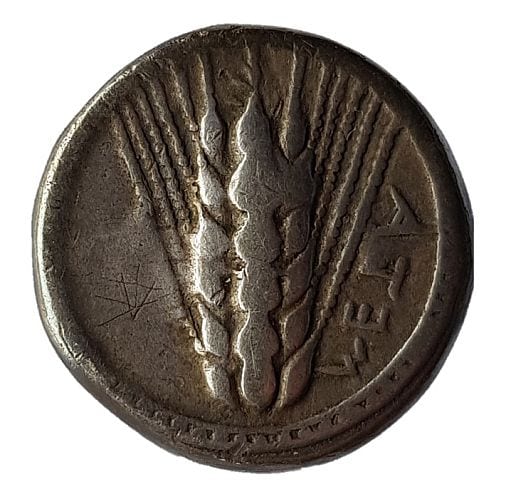
Barley Ear
LUCANIA, Metapontion
Silver Nomos – 470-440 BCE
6.87g/19.5mm/VF
Image – Roger Spencer
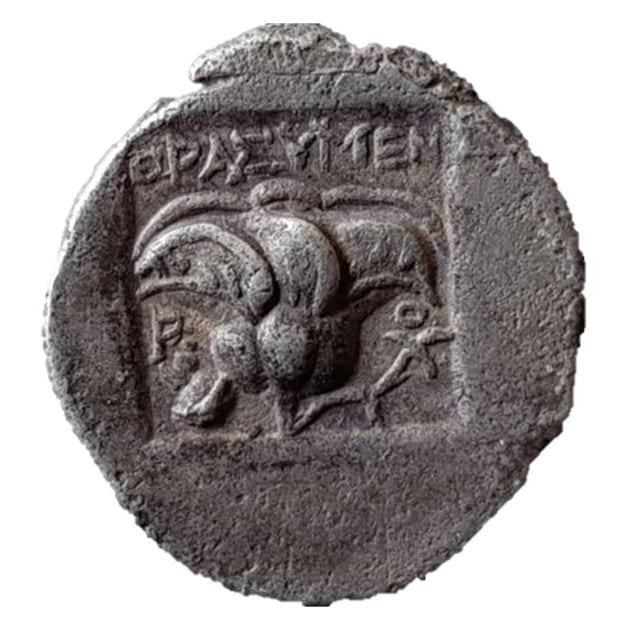
Rose of Rhodes
Hemidrachm -167-88 BCE
A punning name with a play on the word Rhoda-red.
The island of Rhodes was the easternmost island of the Aegean under Greek influence and the rose was the
polis emblem used on much of its coinage
Image: Roger Spencer
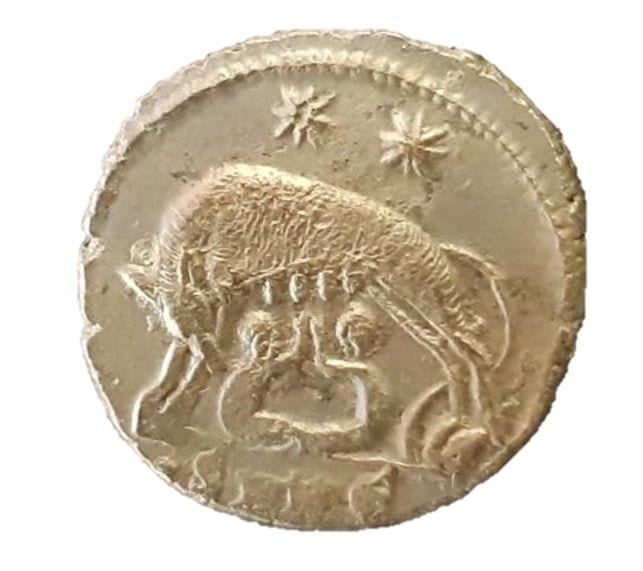
Romulus & Remus
Emperor Constantine (306-337 CE)
Emperor Constantine minted this coin in 330 CE commemorating the legendary foundation of Rome by twins Romulus and Remus who were suckled by a She-wolf.
Bronze 2.0g/17mm
Image: Roger Spencer
ROMAN EMPERORS
1st CENTURY CE
Augustus – 31 BCE –14 CE
Tiberius – 14–37
Caligula – 37–41
Claudius – 41–54
Nero – 54–68
Galba – 68–69
Otho – Jan,-Apr. 69
Aulus Vitellius – July–Dec. 69
Vespasian – 69–79
Titus – 79–81
Domitian – 81–96
Nerva – 96–98
2nd CENTURY CE
Trajan – 98–117
Hadrian – 117–138
Antoninus Pius – 138–161
Marcus Aurelius – 161–180
Lucius Verus – 161–169
Commodus – 177–192
Publius Pertinax – Jan.-Mar. 193
Marcus Julianus – Mar.-Jun. 193
Septimius Severus – 193–211
3rd CENTURY CE
Caracalla – 198–217
Publius Sept. Geta – 209–211
Macrinus – 217–218
Elagabalus – 218–222
Severus Alexander – 222–235
Maximinus – 235–238
Gordian I (Mar.-Apr.) – 238
Gordian II (Mar.-Apr.) – 238
Pupienus Max. (Apr-July) – 238
Balbinus (Apr.-July) – 238
Gordian III – 238–244
Philip – 244–249
Decius – 249–251
Hostilian – 251
Gallus – 251–253
Aemilian – 253
Valerian – 253–260
Gallienus – 253–268
Claudius II Gothicus – 268–270
Quintillus – 270
Aurelian – 270–275
Tacitus – 275–276
Florian (Jun.-Sept.) 276
Probus – 276–282
Carus – 282–283
Numerian – 283–284
Carinus – 283–285
Diocletian (E Empire) 284–305
– divided empire into E and W
Maximian (W Empire) 286–305
4th CENTURY CE
Constantius I – W 305–306
Galerius – E 305–311
Severus – W 306–307
Maxentius – W 306–312
Constantine I – 306–337 (reunif.)
Galerius Val. Max. – 310–313
Licinius – 308–34
Constantine II – 307–340
Constantius II – 337–361
Constans I – 337–350
Gallus Caesar – 351–354
Julian – 361–363
Jovian – 363–364
Valentinian I – W 364–375
Valens – E 364–378
Gratian – W 367–383
– coemperor with Valentinian I
Valentinian II – 375–392
Theodosius I – E 379–392
E& W 392–395
Arcadius – E 383–395
– coemperor
395–402 sole emperor
Magnus Maximus – W 383–388
Honorius – W 393–395
– coemperor
395–423 sole emperor
5th CENTURY CE
Theodosius II – E 408–450
Constantius III – W 421 co-emp.
Valentinian III – W 425–455
Marcian – E 450–457
Petronius Max. – W Mr–My 455
Avitus – W 455–456
Majorian – W 457–461
Libius Severus – W 461–465
Anthemius – W 467–472
Olybrius – W Apr.-Nov. 472
Glycerius – W 473–474
Julius Nepos – W 474–475
Romulus August.- W 475–476
Leo I – E 457–474
Leo II – E 474
Zeno – E 474–491
CHINESE DYNASTIES
BCE
Xia dynasty 夏朝 - 2070–1600
Shang dynasty 商朝 - 1600–1046
Zhou dynasty 周朝) - 1046–256
No title Son of Heaven - 256 to 221
Qin dynasty 秦朝 - 221–207
CE
W'stn Han d'y 漢朝 - 202 BCE–25 CE
Xin dynasty 新朝 - 9–23
Eastern Han dynasty - 25–220
Three Kingdoms 三國 - 220–280
Jin dynasty 晉朝 - 266–420
16 Kingdoms 十六國 - 304–439
N & S dynas's 南北朝 - 386–589
Sui dynasty 隋朝 - 581–619
Tang d'y 唐朝 - 618–690, 705–907
5 dy's & 10 kd's 五代十國 - 907–979
Liao dynasty 遼朝 - 916–1125
N'thn Song d'y 宋朝 - 960–1127
Southern Song 宋朝 - 1127-1279
Liao Dynasty - 907-1125
Western Xia 西夏 - 1038–1227
Jin dynasty 金朝 - 1115–1234
Yuan dynasty 元朝 - 1271–1368
Ming dynasty 明朝 - 1368–1644
Qing dynasty 清朝 - 1636–1912
Empire of China 中華帝國
- 1915–1916
Taiping Rebellion - 1850 - 1864
Republic - 1912-1949
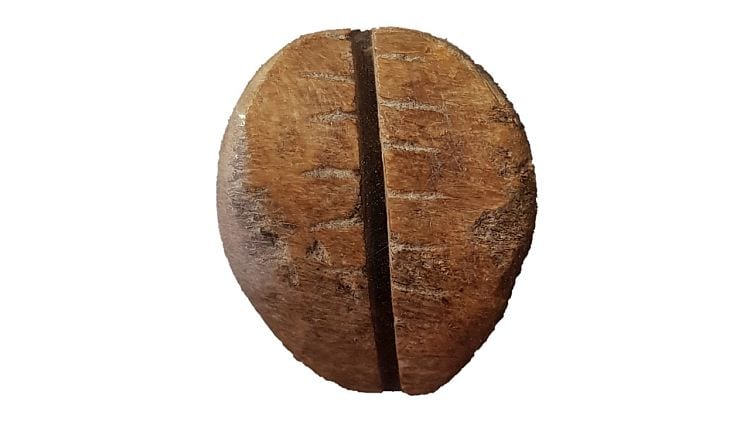
Chinese Bone Cowrie[11]
In pre-history, Cowrie shells were used as commodity money across the Indo-Pacific region, sourced mostly from the Maldives and South China Sea. They were of special value in the Shang Dynasty (c. 1766 – 1154 BCE) but by the time of the Western Zhou Dynasty (770 BCE – 256 BCE) were being replaced by imitation shells made of bone and other materials.
22 mm long, 18 mm wide
Image: R. Spencer

Chinese Bronze Ant Nose Money
Chu Warring States – c. 475 BCE
Also called ‘ghost face’ money because of the face-like appearance of the Chinese characters. These coins and cowries were often pierced and strung together – no doubt a precedent for the later cash coins
18 mm long, 13 mm wide
Image – Roger Spencer
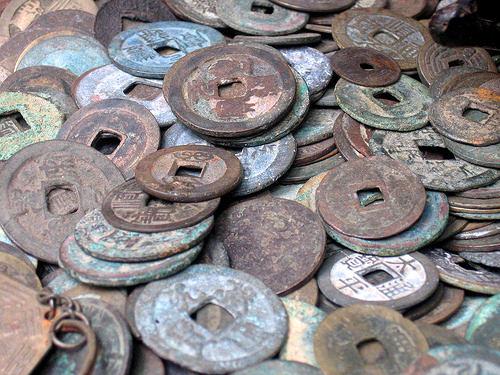
Chinese Cash Coins
The Chinese treated gold and silver as bullion. These copper-based cash coins were used as currency for around 900 years, but without the use of imagery.
Courtesy Wikimedia Commons – Accessed 10 June 2021
German States
Ferdinand III – Augsburg – 1 Thaler – 1642
Minted 1639-1645 – Silver/28.9g/42mm
Obv: Image of the city within a circle, baroque ornaments, angel above, pine cone (symbol of Augsburg) in the middle.
Date divided in the lower ornaments. AVGVSTA·VIN DELICORUM (Latin name for Augsburg)
Rev: Armoured bust to the right, legend around. IMP:CÆS:FERD:III·P·F·GER:HVN:BOH:REX·
KM# 77, Dav EC IV# 5039 $500
Screw press
The screw press was introduced to England in 1553 by French engineer Aubin Olivier together with rollers for reducing the cast bars and machines to punch out round disks, or planchets, from flattened sheets of metal. The manpower needed for this process was later replaced by horses, mules, and water-power.
Tower Mint – England
In a proclamation of 1560 Elizabeth I of England exchanged old debased coins for new pure ones, the Tower Mint adding machinery for this recoinage.
Later, in 1632 Charles I employed another French refugee, Nicholas Briot, to improve coin standards in England and Scotland (which had its own coinage until 1707) but the English Civil War ended this venture. Eventually, in 1662, Charles II employed Frenchman Blondeau to establish a permanent system of machined or milled coinage. This used a secret method to place lettering and designs on the edges of coins, often the inscription—DECVS ET TVTAMEN (‘An ornament and a safeguard’) which hampered the ‘clipping’ of coin edges. Even so, hammered coins remained in circulation until demonetized in 1695.
Steam Press
By 1786, most of the coins in circulation in Britain were counterfeit, a situation that worsened when the Royal Mint was closed. With the Industrial Revolution, though paper currency was available, there was a demand to pay the factory workforce with copper coins.
Industrial techniques and steam-power was introduced by Matthew Boulton of Birmingham in 1788 as an extension to the small metal products he already manufactured in his factory in Soho. He invented a steam driven screw press in the same year.
Matthew Boulton used Watt’s Steam Engine to power coin milling at his Soho Manufactory in Birmingham which struck private tokens, and coins for the East India Company, and provided steam powered coin mills to the Moscow mint. In 1797 Boulton was given the contract to strike royal British copper pennies and twopences called cartwheels. In 1805 the Royal Mint moved from the Tower of London to Little Tower Hill.
Boulton installed eight steam-driven presses, each producing 70 to 84 coins per minute. Struggling to get a license to strike British coins Boulton began striking coins for the British East India Company, Sierra Leone, and Russia on high-quality planchets that were used by national mints elsewhere. Over 20 million blanks were sent to Philadelphia for the striking of cent and half-cent coins in America.
This marked the beginning of modern coin mass-production by steam driven machinery in factories to an elaborate design with standard dimensions, weight and shape such that counterfeits were easily detected. Heinrich Küchler added further precaution by using a raised rim with incuse or sunken letters and numbers. Boulton was rewarded for his efforts with a contract to the Royal Minton 3 March 1797 for the production of cumbersome penny and twopenny copper ‘cartwheel’ coins. Pennies measured exactly an inch and a half, so that 16 pennies edge-to-edge in a line extended two feet.
Boulton’s original machinery was taken over by the Royal Mint and used until 1881.
Uhlhorn Press
Between 1817 and 1830 the German engineer Dietrich “Diedrich” Uhlhorn invented the highly efficient Presse Monétaire (Uhlhorn Press), a level coin or steam-driven knuckle-lever press adopted internationally. More than 500 units were distributed by 1940, replacing the screw press. The new technology was also used in the Birmingham Mint which was the largest private mint in the world for most of the 19th century. Further improved by Taylor and Challen complete press room machinery was then used in national mints around the world, including the Sydney Mint in Australia.
By the early 20th century, mints were using electrical power to drive rolls, the advantage being that each pair of rolls could be driven independently without the intervention of cumbrous shafting.
The dollar
In the 16th century, Count Hieronymus Schlick of Bohemia (a one-time kingdom of the Holy Roman Empire that became part of the Habsburg Monarchy, then the Austrian Empire and now the western Czech Republic) minted a coin, the Joachimsthaler (German thal, or Tal, meaning ‘valley or ‘dale’) named after Joachimsthal, a valley in the Ore Mountains where the silver was mined. Joachimstaler was then shortened to taler, a word that eventually found its way into Norwegian, Danish and Swedish as daler, Russian as талер (táler), Czech and Slovene as tolar , Polish as talar, Dutch as daalder, Amharic as ታላሪ (talari), Hungarian as tallér, Italian as tallero, Greek as τάληρο (taliro), Spanish tálero and English as dollar.
America’s Morgan Dollar
In 1876 Englishman George T. Morgan became assistant engraver at the Philadelphia Mint. He had studied under the outstanding English engraver Leonard Charles Wyon. Morgan enrolled in the Philadelphia Academy of Fine Arts knowing the Mint Director wanted the head of Liberty on the new silver dollar. American painter Thomas Eakins guided him in the study of Greek profiles using schoolteacher Miss Anna Williams as subject. By early 1877 he had created the exceptional new design now known as the Morgan dollar which was struck from 1878 to 1904, and then in 1921 continuing the Liberty profile first used on American silver dollars of 1794 to 1804, the Liberty Head replacing the Seated Liberty design.
French 1851 Liberty Head of Ceres, struck 70 years before the Morgan Dollar, shows the continuity in Western iconography
Morgan dollar
The American Morgan Dollar is an icon of the time when America was gaining in global political and economic influence, filling the imperial vacuum left by Britain struggling from the cost of two world wars. The coin retains in its design much of the classical symbolism used by the ancient Greeks and adopted by imperial Britain.
Liberty teacher (Anna Williams) wears a Phrygian cap encircled with a ribbon inscribed with the word ‘LIBERTY’. The Phrygian or ‘liberty’ cap is a soft conical cap with a nodding tip, originally associated with Eastern European Anatolia, Phrygia, Dacia, and the Balkans. During the French Revolution it signified freedom and liberty. The classical symbol of liberty was the Roman pileus, a felt cap worn by manumitted (emancipated) slaves of Ancient Rome as worn by Libertas, the Roman goddess of liberty.
A crown of cotton and wheat, staples of the country, decorate the area above the ribbon. Above Liberty’s head on the silver dollar, are the words ‘E PLURIBUS UNUM’ (‘One from many’ referring to the union of the original 13 American colonies into a single nation). There are 13 stars below Liberty’s head – 7 to the left of the date and 6 to the right. The Morgan dollar designer’s initial, a single M, is at the nape of Liberty’s neck. On the reverse is the eagle with its wings spread. Between the eagle’s outstretched wings is ‘IN GOD WE TRUST’. Across the top of the Morgan dollar’s reverse is ‘UNITED STATES OF AMERICA’. The eagle holds in its claws both an olive branch and 3 arrows, symbolizing peace and readiness for war. Above the denomination, ONE DOLLAR, is the mint mark and a wreath of laurel. On the ribbon, which ties the laurel wreath, is another M for the designer George T. Morgan.
Dollar sign
The dollar symbol ‘$’ has been associated with a stylization of the letters ‘US’, or the pillars that appeared on the Mexican 8 Reales coin of the colonial era. Modern research (see Media Gallery) has determined that it was the widely used Spanish peso whose written abbreviation as ‘PS’ or ‘PSO’ that had become stylized by the 1760s into the dollar sign becoming in general use in New York by 1776 and in print media by 1802.
Spanish coinage
Following the introduction of the Guldengroschen in Austria in 1486, the utility of a large silver coin with high purity was recognised throughout Europe – a situation recalling the ancient Greek ‘owls’.
Monetary reform in Spain (the dominant military, economic and political power at that time) in 1497 resulted in the introduction of the 8-real (1-peso) coin according to strict specifications:
• 1497 – $83⁄8 to a Castilian mark of silver (23.0465 grams), 1134⁄144 or 0.9306 fine (25.563 g fine silver)
• 1728: $8.50 to a mark, 111⁄12 or 0.9167 fine (24.809 g fine silver)
• 1772: $8.50 to a mark, 1130⁄144 or 0.9028 fine (24.443 g fine silver; but true fineness 1772–1821 probably only 0.89.
This was supplemented in 1537 by the gold escudo, minted at 68 to a mark of gold 0.917 fine (fineness reduced to 0.906 in 1742 and 0.875 in 1786). It was valued at 15–16 reales or approximately 2 dollars. The famous Spanish Gold Doubloon was worth 2 escudos or about 4 dollars.
From the 15th to the 19th centuries the coin was minted with several different designs at various mints in Spain and the New World, having gained wide acceptance beyond Spain’s borders. Thanks to the vast silver deposits that were found mainly in Potosí in modern-day Bolivia and to a lesser extent in Mexico (for example, at Taxco and Zacatecas), and to silver from Spain’s possessions throughout the Americas, mints in Mexico and Peru also began to strike the coin.
The major New World mints for Spanish dollars were at Potosí, Lima, and Mexico City (with subsidiary mints at Bogotá, Popayán, Guatemala City, and Santiago), and silver dollars from these mints could be distinguished from those minted in Spain by the Pillars of Hercules design on the reverse.
The dollar or peso was divided into 8 reales in Spanish Latin America until 19th century when the peso was divided instead into 100 centavos. However, monetary turbulence in Spain beginning under the reign of King Philip II resulted in the dollar being subdivided as follows in Spain only:
• Until 1642: $1 = 8 reales, subsequently called reales nacionales
• From 1642: $1 = 10 reales provinciales
• From 1687: $1 = 15 2⁄34 reales de vellón (made of billon alloy; edict not effective)
• From 1737: $1 = 20 reales de vellón
• In 1864: $1 = 2 silver escudos (different from the gold escudo)
• And finally, in 1869: $1 = 5 Spanish pesetas, the latter at par with the French franc in the Latin Monetary Union.
Spain’s adoption of the peseta in 1869 and its joining the Latin Monetary Union meant the effective end of the last vestiges of the Spanish dollar in Spain itself. However, the 5-peseta coin (or duro) was slightly smaller and lighter but was also of high purity (90%) silver.
In the 1990s, commemorative 2,000-peseta coins were minted, similar in size and weight to the dollar and also with high fineness.[3][4]
China and the Far East
Inspired by the silver Spanish dollar, Silver Dragon (Dragon dollars) were issued by China, Japan and later Korea following its use in the 16th Century as the common currency for trade in the Far East. A dragon was depicted on the obverse of Japanese and Korean issues and on the reverse of Chinese issues, the specification being a weight of 27.22 grams and a fineness of .900 (24.5 g or 0.7876 troy oz) of silver.
With the Spanish colonization of the Philippines, the city of Intramuros became an entrepôt for Chinese goods on one trade route and silver, from across the Pacific to the Spanish held silver mines of Mexico, in the other. This was the Manila Galleons trade route that, from the 16th century accepted Spanish dollars or ‘pieces of eight’. Even after the demise of the Spanish Empire in the Americas, Western nations trading with China found that payments were made with the silver Mexican Peso, the successor to the Spanish dollar. It also led to the minting of silver Chinese yuan, Japanese yen and later Korean won (the names derived from 圓, meaning round or circular object in all three languages) to the same specifications, that is, a weigh of 7 mace and 2 candareens (approx. 27.22 grams or 420 grains) and a fineness of .900 (90%). These coins joined trade dollars and colonial currencies such as the Hong Kong dollar and the Straits dollar. Japan also produced a trade dollar for external use which differed slightly from the domestic yen coins. The common standard facilitated trade as, theoretically they were interchangeable.
Chinese coins of this type are known as Kwangtung dollars and in Chinese as 龍銀, literally Dragon Silver or Dragon Money, 銀.
Collecting silver dragon coins is risky as there are many counterfeits to the point where historical fakes have gained such numismatic value that there are now modern fakes of historical fakes.

Chinese Dragon Dollar
Counterfeit coin
The European Union
On 1 January 1999 the third stage of the European Monetary Union came into effect with the euro the shared currency of 11 EU countries. Coins of the EU have a common reverse side designed by Luc Luycx of the Royal Belgian Mint, and a national obverse with its own designer.
Coin art
Art & design
Are the images on coins art?

Gold 20-stater of Eucratides I (reigned c. 171–145 BCE)
Eucratides was one of the most important Greco-Bactrian kings in a line of descent from Alexander the Great. This coin is the largest known gold coin from antiquity, it weighs 169.2 g (5.97 oz) and has a diameter of 58 mm. It was originally found in Bukhara, Uzbekistan. Acquired by Napoleon III, it is now stored in the Cabinet des Médailles, Paris.
This image comes from the Gallica Digital Library.
Courtesy Wikimedia Commons – Accessed 4 April 2020
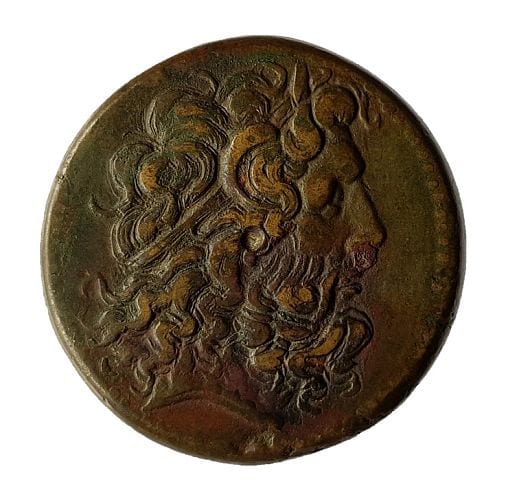
PTOLEMAIC KINGDOM OF EGYPT
Ptolemy III – Euergetes
1 DRACHM – 246 – 222 BCE
Obv: Diademed head of Zeus Ammon to right, with ram’s horn in his hair and over the diadem
Bronze – 68.25g/40mm/5mm
Ref: SvoronosPt# 964, SNG Cop# 171 F
Image: Roger Spencer
This portrait of Ptolemy III demonstrates obvious artistic talent with the flowing folds of hair and depth of character in the face. This is what distinguishes the artistic from the more functional, stylized, or coldly realistic portraits that have been used on subsequent coinage
In coins this question is often addressed as a distinction between fine art and graphic design. Many designers would consider themselves to be artists, yet few artists would class themselves designers. Design tends towards a clear message communicated through a refined technique or craft that is readily understood – its function tends towards a simple selling or communication of a product, service, or idea. Art tends towards images requiring some empathic engagement and interpretation (often in many ways) that entail the creative imagination. The skills of design are more easily learned and passed on than those of artistic creative imagination.
The two galleries above illustrate this gradation of ideas:
The 1935 ‘Rocking Horse Crown’ depicts a stylized horse and knight above a dragon. This is pleasing to the eye but formulaic and, like a rocking horse, ‘wooden’ in character. It is technically well executed and was, no doubt, the deliberate intention of the ‘artist’. It is a design that serves its purpose adequately, but there is little challenge to our imagination or intellect. The 1933 ‘Wreath Crown’ presents us with a satisfyingly complex pattern of repeated British floral emblems, and although such a design requires considerable technical dexterity, it still lacks creative ingenuity. The last coin is the famous engraver Pistrucci’s representation of ‘Saint George and the Dragon’ on a crown minted in 1819. Again, the coin is neatly designed with a pleasing peripheral legend and an image of carefully considered composition. The horse and figure are extremely skillfully executed and engage the viewer with the drama of the scene. Though high-quality art is not necessarily ‘dramatic’, the well organised drama on this coin is a useful device that captures the viewers imagination. Pistrucci’s scene is presented in the ancient Greek or classical style and there are those that would feel that ‘art has moved on’ – but the comparison still bears thinking about nevertheless.
All three of these coins exhibit both ‘design’ and ‘art’ but, in my view, and I believe many other people, the Pistrucci has the greatest ‘artistic’ content. At the height of the British Empire in the late 19th century when some of Britains most beatiful designs were produced, exceptional celators like Benedetto Pistrucci and William Wyon were formally trained sculptors.
Greek genius
At the dawn of world coinage the ancient Greeks created some of the world’s finest engraved coin imagery, most notable among this being the miniature portraiture. These representations of the gods display highly developed artistic skills alongside the technical ingenuity of master craftsmen struggling, no doubt, with the limitations of small dies and the crude hammering of the metal planchets.
The iconographic styles on Greek coins are generally divided into three periods, their distribution expanding with each one. In the Archaic period they were distributed mainly in Greece, the Aegean Islands, Ionia, and Magna Graeca. In the classical period this distribution extended north into Macedonia, and easterly into Anatolia. Then, following the military campaigns of Alexander they were minted for trade that extended as far east as the Indus, including the eastern Mediterranean, south to the Nile Valley, and including western north Africa.
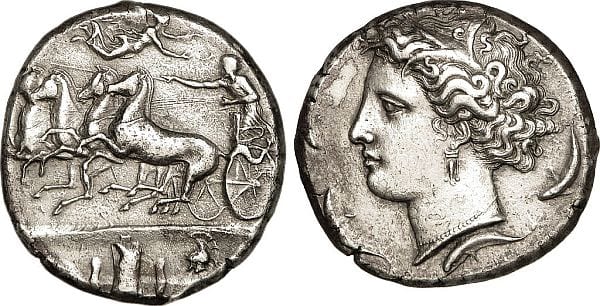
Syracuse – Silver Dekadrachm – c. 400 to 380 BCE
The obverse shows a charioteer, wearing long chiton, holding goad in his right hand and the reins in his left, driving the four-horse racing chariot called a quadriga. Nike, goddess of Victory, is flying above, preparing to crown the charioteer. In the exergue a panoply of arms.
The reverse is a portrait of Persephone whose hair is bound in a wreath of reeds. She wears a pearl necklace and a triple-pendant ear-ring. Around her swim four dolphins. These are engaging, as well as functional, images. Chariot-racing was the ultimate sporting contest at this time.
The largest silver coin denomination in ancient Greece (34 mm, 43.09 g), these coins now sell for tens of thousands of dollars.
Courtesy Wikimedia Commons – cgb.fr – Accessed 12 July 2020
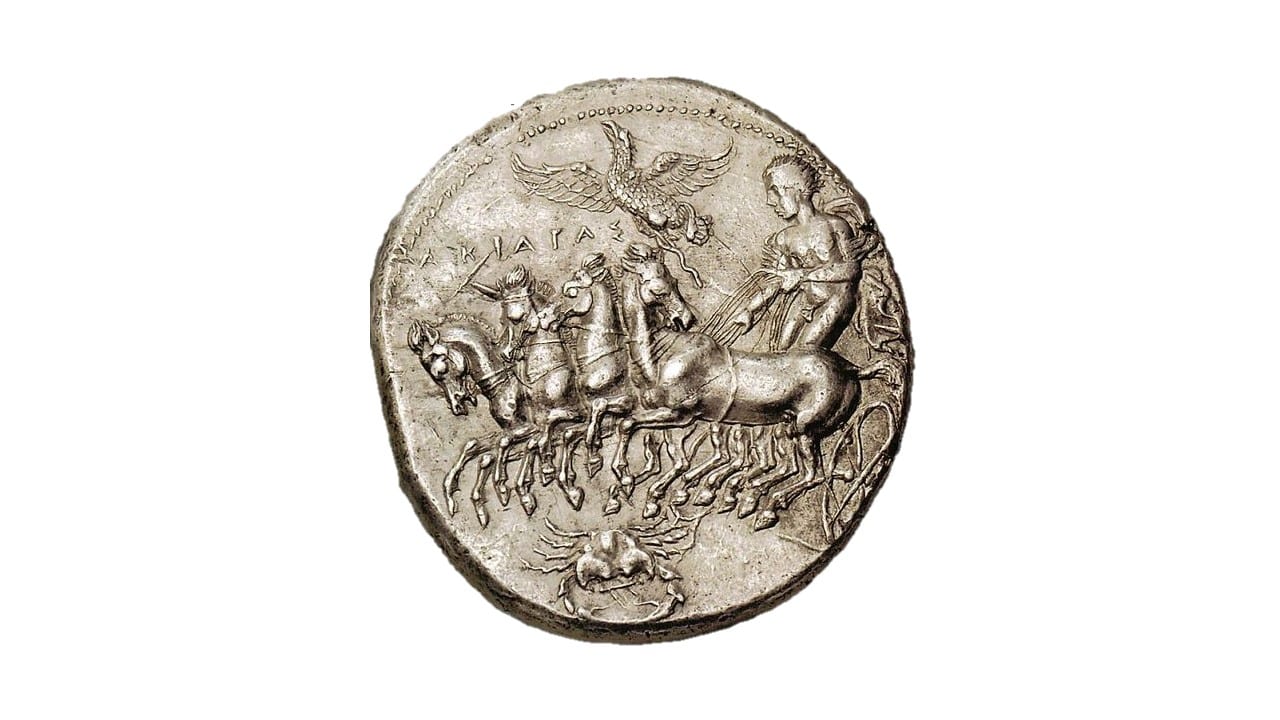
Archaic period (650 to 480 BCE)
Lasted from the introduction of coinage until the Persian Wars with mints in Lydia, Ionia, Aegina and Athens. Coins of this period are generally quite scarce and with crudely produced portraits of the gods and emblems of city-states.
Classical period (480 to 337 BCE)
The period from 480 to 415 BCE is often treated as a transitional time with the inclusion of many more regions and more sophisticated iconography. From the Persian Wars to the reign of Alexander the Great is considered the high point of the classical era when some of the world’s most accomplished coin iconography was produced by Greece’s master sculptor-engravers. The style had now become more refined although the designs were still essentially obverse portraits of the gods and reverse emblems of city-states.
Hellenistic period (337 to 30 BCE)
This period lasted from the reign of Alexander the Great to the death of Egypt’s Cleopatra and the ascendency of Roman rule. Alexander’s portrait replaced those of the Olympian gods as ‘Alexanders’ replaced ‘Owls’ as the major currency. Coins were minted in much greater numbers and of lesser quality. The style of portraiture is now more naturalistic, often depicting reigning monarchs and now including large kingdoms as well as city states. It was towards the end of the Hellenistic period that Greek kingdoms and city states were absorbed into the Roman empire. However, Greek city states continued to mint coins, often bronze, under the Roman Empire, these usually falling under the headings ‘Roman Provincial’ or ‘Greek Imperial’.
It was Ami who created the wheat ears of Metapontion, Euainetos the decadrachm of Syracuse and silver drachm of Katana, Kimon the head of Arethusa that was copied across the Greek world, Parmenides a master engraver of Syracuse, Prokles whose magnificent miniature portraits often included a leaf with fruit (probably a laurel).
The Roman coins that followed lacked the artistic inspiration of the Greek celators, becoming artistically unadorned objects of exchange bearing functional designs.
The balance between graphic design and artistic creativity has shifted through history, with new technology opening up the possibilities of new metals, alloys, colouring, and pressing effects.
Commentary
The purpose of this articles has been to explore what may be learned from the images of plants appearing on metal coins throughout history and I am sure much more is to be learned from plant images on stamps, banknotes and other historical artefacts. But before doing this it is helpful to take a look at coins as indicators of social development (a key sustainability indicator).
Coin production presupposes: the production and processing of metals; the distribution of coins within a community of traders that accepts their uniformity of value; the means of distributing the coins over quite large areas. All this requires some stability of governance, a developing science and technology of spcialist artisans; a sophisticated system of economics, trade, transport and communication.
Money & Debt
CrashCourse World History – John Green – 2014 – 14:03
How is Money Created? – Everything You Need to Know
ColdFusion – 2020 – 29:55
The History of Coins & Currency – 600 BCE to 1500 CE
Ollie Bye – 2019 – 5:07
Getting to Know Eric P. Newman, Part 4: Origin of the Dollar Sign
Lianna Spurrier – 2020 – 9:45
The History of Coins & Currency (part 2) – 1500 – 2019
Ollie Bye – 2019 – 2:31
Hammered Coin Manufacture
oldclaypaws – 2011 – 5:35
First published on the internet – 1 March 2019
. . . revised – 30 May 2021
. . . minor edit – 12 June 2021
. . . 29 July 2023 – minor edit
Set of botanical portraits, Armenia 2014, 200 dram coins: Oriental Plane – Platanus orientalis; Pine tree, Pinus kochiana; Oak, Quercus araxina; Aspen, Populus tremula; Beech, Fagus ortientalis
Images – R. Spencer, 2019

